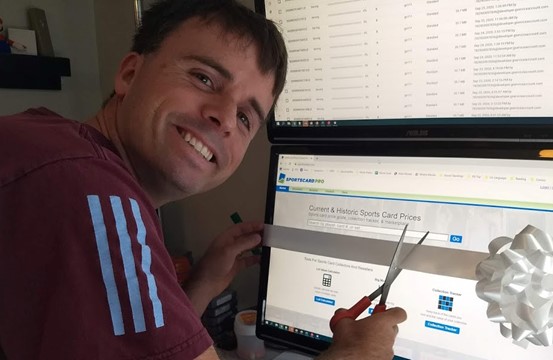This inspiring story is of a rising startup called SportsCardPro started by JJ Hendricks. SportCardPro provides accurate and easily accessible prices for sports card collectors and retailers. They also, provide tools for card collectors like a collection tracker and lot value calculator. Here is the story of SportsCardPro in JJ’s own words.
Introduce us to the idea of SportsCardPro
SportsCardPro reports the value for sports card in ungraded and graded conditions. We are the only site that calculates current value for sports card in multiple conditions and shows them on one page.
Ungraded and graded cards can be worth vastly different amounts so we make it easy for people to find the pricing of their sports card in any condition. Michael Jordan’s rookie card is worth about $1,000 ungraded but in the highest grade of PSA 10, it sells for $200,000.
We also track historic prices so people can see if their sports card are increasing in value. SportsCardPro has an integrated collection tracker so people can keep track of what cards they own, quickly add cards to their collection, and then know the value of their entire collection. Collectors can see the historic value of their sports card collection too and see how much it’s increased over time.
What’s your strategy story? What led you to start SportsCardPro?
In January 2020 I had to close a business I was running for the last 20 years. That business was an online retailer of retro games but the business was losing money. As a side hustle, I was running a site that keeps track of video games prices for collectors and other stores.
After my business closed down I had more free time and I was considering what to do in the future. In late spring a sports card enthusiast, George Prevost, contacted me about sports cards and using the tech I had built in my side business to track sports card prices too.
I used to collect baseball and football cards as a kid but hadn’t been active in the hobby for years but I still loved sports. During COVID lockdowns sports cards were becoming really popular again. George and I decided to work together to launch SportsCardPro.
What marketing, operation strategies are you adopting?
Our business started as a fully remote workforce because George and I live in two different states. COVID prevented in-person meetings, and our business is entirely online. This has kept our overhead at $0 since there is no rent, utilities, or other costs.
We plan to keep a fully remote workforce as we grow too. Our largest expenses are website hosting and marketing. For hosting we are using Google Cloud services so we don’t need IT people working on servers.
For marketing, we are focusing on free methods to keep costs low. We are doing in house search engine optimization, social media marketing, and planning for word of mouth.
Sports cards has a big community with lots of people talking about the hobby with fellow collectors so word of mouth can be huge in our industry. We are spending some money on Google ads to reach people searching for really focused keywords. This also helps us hone our on-site copy because we can quickly test ad copy and see what words and phrases resonate with our audience and include those on our website too.
Any strategy mistakes you have made and what did you learn?
The biggest mistake we made were adding incomplete data to our site and not growing into new sports quickly enough. When we first launched we only tracked basketball cards. Our database didn’t include every basketball card because we wanted to save time adding to the database.
An incomplete database led to pricing mistakes, which took much longer to fix than uploading the correct data, to begin with. I also dragged my feet longer than I should have on adding new sports to the site. I wanted to get the backend code working better before adding to the database but this decision just slowed our growth. I’ve learned spending a little more time getting something right at first can reap long term time savings in the future.
Finally what advice do you have for your fellow entrepreneur readers?
If you are starting a business at home, make sure to have a different physical space for work vs family. If they are the same place it is too easy for work to creep into personal time and personal stuff to creep into work time. A different physical space helps to switch on/off work vs personal time. Business wise, I’ve learned to be flexible. In several months I went from shutting down one business to launching another in a completely different space.
Disclaimer: The information in the above story is provided by the startup and The Strategy Story takes no responsibility for the authenticity of the product and services offered by the startup. Reader’s discretion is advised.
Check out stories of other aspiring Entrepreneurs
Also check out our most loved stories below

Johnnie Walker – The legend that keeps walking!
Johnnie Walker is a 200 years old brand but it is still going strong with its marketing strategies and bold attitude to challenge the conventional norms.

Starbucks prices products on value not cost. Why?
In value-based pricing, products are price based on the perceived value instead of cost. Starbucks has mastered the art of value-based pricing. How?

Nike doesn’t sell shoes. It sells an idea!!
Nike has built one of the most powerful brands in the world through its benefit based marketing strategy. What is this strategy and how Nike has used it?

Domino’s is not a pizza delivery company. What is it then?
How one step towards digital transformation completely changed the brand perception of Domino’s from a pizza delivery company to a technology company?

BlackRock, the story of the world’s largest shadow bank
BlackRock has $7.9 trillion worth of Asset Under Management which is equal to 91 sovereign wealth funds managed. What made it unknown but a massive banker?

Why does Tesla’s Zero Dollar Budget Marketing Strategy work?
Touted as the most valuable car company in the world, Tesla firmly sticks to its zero dollar marketing. Then what is Tesla’s marketing strategy?

The Nokia Saga – Rise, Fall and Return
Nokia is a perfect case study of a business that once invincible but failed to maintain leadership as it did not innovate as fast as its competitors did!






